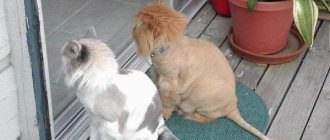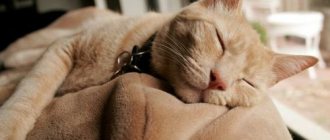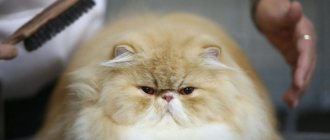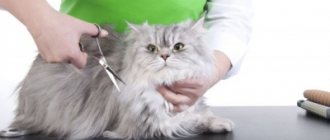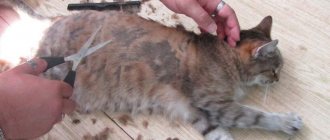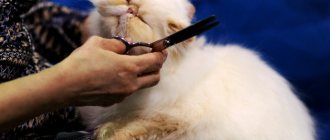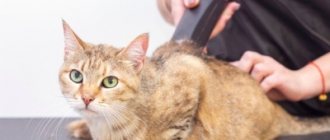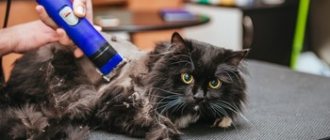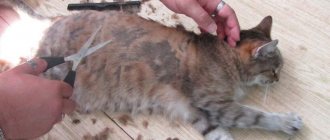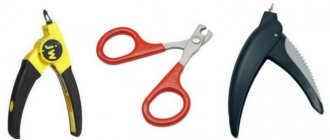Grooming a domestic cat on your own is a very difficult and responsible task. For a handsome furry cat, such an event, conducted illiterately and unprofessionally, can turn into real stress. If you still decide to do the haircut yourself, without the help of a professional hairdresser and at home, then you should first familiarize yourself with the recommendations of professionals so as not to harm your pet.
Types of wool
The coat of cats can be divided into four main categories: long-haired, smooth-haired, short-haired and hairless (cats with no hair - Donskoy and other Sphynx cats).
Taking care of long hair (up to 15 cm) is considered the most difficult, although short-haired cats, whose hair may not have undercoat or guard hair, require care.
Many felinological organizations classify primarily the Nibelung, a Persian breed, as long-haired cats. In addition, in some associations the British Longhair and the Highland (Scottish Semi-Longhair) are listed in the "longhair" category.
At a certain period of time, the British and Scots used Persians to obtain long wool, and the structure of the coat is inherited genetically.
Grooming kit
The coat of the Persian breed requires care more often than others. Persian cats cannot fully groom their fur. Their coat is thin, thick and long, with a pronounced undercoat.
In the absence of the necessary care, the hair becomes matted and tangles appear. In this case, it will take a lot of time to comb out and trim the tangles, and the process will give the cat unpleasant sensations.
The coat of cats of the Maine Coon, Siberian, Ragdoll, and Somali breeds is considered semi-long, but differs in texture. Thus, the Maine Coon and the Siberian have clearly defined outer coat (guard) hair, the undercoat is present, it is soft and thin. Ragdolls have a silky coat, but very little undercoat. These facts must be taken into account when choosing a cutting tool.
Why do you need a haircut?
Grooming cats, unlike grooming six dogs, is more of a hygienic and preventive nature than aesthetic, and here's why.
- Cats with long hair tolerate heat less well and there is a danger of overheating.
- Cats with long hair are more likely to develop mats.
- The functioning of the digestive tract may be disrupted due to the large amount of hair in the stomach.
Owners of pets with long and semi-long hair cite the formation of tangles as the most common problem. The animal is not able to get rid of dense lumps on its own. Felt-like lumps form close to the skin. Cutting mats takes several hours and is a traumatic process for both the animal and the owner. It is difficult to carry out such a procedure with scissors; you will need a special tool - a tangle cutter. The question of the beauty of a haircut in such a situation does not even arise.
There is another unpleasant outcome associated with tangles and the hot period of the year. Many owners take their pets outside the city in the summer.
Warning! When mats form, the cat tries to lick the fur itself and begins to bite the mats. At the same time, it can damage the skin. The resulting wounds can be used by flies to lay their eggs. The result for the cat will be very sad.
There are model cat haircuts, which are carried out mainly before exhibition events. With this procedure, some imperfections in coat growth are “polished” to give a flawless appearance.
Some cat owners turn to beauty salons for smaller cats even for a hygienic haircut. However, not all cats can calmly tolerate the sound and vibration of a special machine, especially the touch of a stranger.
What clippers and trimmers are needed to care for a cat's claws and what is their price?
Some members of the feline family also panic during transportation, and in such cases, the use of sedatives is not a necessity, but an obligation.
Grooming aggressive cats
It is recommended to use special collars for grooming aggressive cats.
Very often, cats behave aggressively during grooming. In such cases, the following recommendations may help:
- Using a plastic collar. Such devices can be purchased at a veterinary clinic or pet store. Before the procedure, it is placed around the animal’s neck and secures its head. In this position, the cat simply will not be able to bite. It is imperative to hold your paws.
- Stationery clip. An ordinary stationery paper clip, which is placed on the scruff of the neck, can calm an unruly pet before a haircut.
- Hair trimming. When using this technique, the fur will remain longer, but the animal itself will behave more docile. This is due to the fact that cutting against the grain irritates the pet, contributing to the appearance of unnecessary aggression.
- Assistant. Grooming a rambunctious cat is much easier and faster with a helper to hold him.
- Use of sedatives and sleeping pills. Overly active pets are sometimes given herbal-based sedatives or sleeping pills. To avoid harm to the cat, the use of such medications should only be carried out under the supervision of a veterinarian.
- Anesthesia. The use of anesthesia to subdue an animal during a haircut is unjustified and can cause irreparable harm to the health and life of the pet. It is carried out only in the most extreme cases and no more than 2 times a year. Before a cat is euthanized to be clipped, she needs to undergo a full examination in order to eliminate all possible risks of complications.
Grooming Tools
Recently, a lot of tools have appeared for grooming cats and dogs, both professional and household. These can be standard clippers, trimmers, and various types of scissors. Many such tools do not require skills, so the owner can cut his pet’s hair for hygienic purposes without resorting to the services of a pet stylist.
The clipper can remove hair to a certain length, but it cannot remove hair from hard-to-reach areas. In such cases, even groomers (zoostalists) use scissors.
Some manufacturers ( Zolux, Ferplast) produce scissors specifically for grooming cats , but most models are universal for the hair of dogs, cats and small animals.
Scissors differ in their purpose (for general cutting, for cutting in hard-to-reach places, for removing tangles), the length of the scissors and blades, the shape of the blades and the type of fastening.
Direct
With sliding cut
Direct
Often used for general haircuts. Thanks to the small patterns applied to the blades, the cuts are clearer and the operation of the scissors is silent. The size of the scissors is selected taking into account the size of the cat.
Curved
Curved
They can also have small notches on the blades. This type of scissors is used for cutting hair on the face, tail, paws and for “shaping” the ears.
They are made from different types of steel, using plastic or silicone to coat the inside of the rings. They can be with or without an adjustable screw.
You need to understand that curved scissors are not a replacement for straight ones, they complement each other. That is why professional groomers use both options.
With adjustable screw
With adjustable screw
Convenient to use due to the ability to increase or decrease the tension of the sheath. They can be either straight or curved.
They also have a finger rest and plastic inserts on the inner surface of the rings. In addition, as a rule, a micro notch is applied to the blades so that the wool does not slip.
It is necessary to monitor the clamping force, otherwise you may end up with a grip on the wool rather than a cut. It is better to first practice with different degrees of tightening of the adjustment screw, so as not to cause pain from pulled hair.
Thinning
Thinning
This type of scissors is designed to thin out the coat without disturbing the texture of the coat. Serrations can be on only one blade (single-sided thinning) or on both blades (double-sided thinning). Thanks to these teeth, the cuts are smooth.
With the help of such scissors you can not only remove the “heaviness” of the wool, but also visually add volume.
Another special feature of thinning scissors is that they always have blunt or rounded tips so as not to damage the pet’s skin.
Special for removing tangles
These are short-length scissors with more rounded tips. The shape of such scissors can be either straight or curved (Zolux, from 700 rubles).
Silent
Silent
Scaredy Cut is an ideal option for a general hygienic cat grooming without visiting a groomer and without stress for your pet. Scissors are a tool with two types of flat blades and several types of plastic combs.
The upper blade of such knives is flat, the lower blade is serrated or without teeth. The set offers 7 sizes of combs for wool of different lengths.
Cat hairstyle trends: which haircut to choose?
If you just need to shorten the coat, this is a simple task. But there is a choice of different curly haircuts, which are chosen taking into account the type of coat, thickness, and breed of the animal. This is a very important factor for winning at the exhibition, because it provides the original appearance of the pet and reflects its individuality.
The following hairstyle options are relevant today:
- “lion”: the entire back and the upper side of the legs are cut, the tail at the base. At the same time, the head is left untouched, as is the neck - a kind of “mane” is formed, as is the tassel at the tip of the tail. The tail can be shaped like a pom-pom, Christmas tree, or panicle. You can achieve the squirrel tail effect. The “socks” on the feet are made short or in the form of “gloves”.
- “puma”: performed similarly to “lion”, but the shirtfront is left in the chest area, which looks beautiful;
- “dragon”: cut the sides and belly until smooth, leave the fur along the ridge and tail, give it the shape of a fluffy comb with incisors;
- “Puss in Boots”: repeating the image of a fairy-tale hero, the hair on the back is cut short, the paws are cut off from above, so that there are neat and identical “boots” below.
There are other models of hairstyles, but they are more complex to perform; it is better to entrust them to groomers. This is the so-called “continental” haircut, “modern”, “harlequin”.
We hope that this guide will help you successfully and tastefully decorate your favorite cat's fur. By following all the above recommendations, you will know exactly how to successfully trim a cat with a clipper at home and create an aesthetically pleasing appearance for your pet.
Manufacturers
The range of tools for grooming cats is quite extensive. The cost varies depending on the brand, purpose of the tool, and material.
Scissors should be easy to use and maintain.
Scissors from the brands Zolux (France), Ferplast (Italy), Trixie (Germany), Witte Rose Line (Germany), Geib Buttercut (USA) have proven themselves well in the household and professional spheres.
The tools from these brands are easy to use and suitable for home care.
Professional scissors are made of durable materials - stainless steel, with an additional titanium coating and therefore will last a long time without losing their qualities.
How to cut your own hair at home
For a calm perception of the tool itself by the pet, it is recommended to first introduce the cat to the scissors, let it sniff, and study the “enemy.”
When using the tool for the first time, you need to make sure that the cat is calm and does not visually react to the scissors, and then try to make cutting movements.
When doing a hygienic haircut, the tangles are cut off first, since ordinary combs will not help here. Felt-like balls often form in the groin and armpits. Removing mats can be called a piece of jewelry, since hairballs form close to the skin and it is very important not to damage the pet’s skin.
Next, the sides are cut. When working with scissors, it is not easy to maintain an equal remaining length of wool, so it is better to use a special machine if beauty is a question.
During the hygienic cutting process, you should not touch the fur on the head, paws and tail.
If necessary, the haircut can be spread over several passes so as not to create an image of danger for your pet. It wouldn't hurt to reward him with some kind of treat.
How to cut a cat's hair with a clipper
The cat clipper should be turned on in advance so that the pet gets used to its sound and is not afraid. In the same way, the cat is cut with a clipper, starting from the sides. The back and stomach are treated, especially carefully trimming the nipple area.
The clipper can cut hair according to its height and against it, using a nozzle of at least 3 mm. If there are lumps and tangles, they should be removed in advance, as the device will not cope with them.
The skin needs to be stretched - this will avoid cuts from the blade. Carefully trim around the intimate area.
At the very end of the work, it is better to cut off the wool with scissors, since contact of the machine with the skin can cause wounds and microscopic scratches. After grooming, the cat must be bathed with shampoo to remove any remaining hair and dirt. Dry with a hairdryer and towel.
Prices, advantages and disadvantages
The advantages of professional tools include high quality materials, durability, and in most cases, ease of use even for novice craftsmen or just owners.
By choosing the necessary tool according to certain parameters, the owner can forget about visiting pet salons, saving money.
The cost of scissors from the professional line starts from 500 rubles, depending on the brand and type.
Silent Scaredy Cut scissors will cost 2000-2500 rubles.
One-time visit to a groomer – from 2500 rubles.
But the professional line is not without its drawbacks.
- With a certain set of advantages (for example, an adjustable screw, rounded ends), the model may have too small a diameter of finger rings.
- Some models require periodic sharpening.
- Not all models have rounded tips, so work with such a tool should be carried out by a specialist.
- The cost of curved scissors with long blades is higher than the cost of other models.
Who is contraindicated for
Fights when trying to cut
any haircut, including silent scissors, is not recommended if the cat is in a state of stress or aggression, has signs of illness, or damage to skin tissue.
It is better to take the necessary pause until your pet calms down, treat him with his favorite treat, and only then resume a new attempt.
An exception is when preparing an animal for surgery, but it is not recommended to do these haircuts yourself. They are more professionally performed directly in veterinary hospitals.
Instrument care
Thanks to the use of high-quality materials, professional line scissors do not require special care.
However, general rules for maintaining metal tools should be followed.
- Scissors should be stored horizontally. The ideal place for storage would be a special case, lined inside with suede or soft fabric.
- Before starting work, you need to check the tension of the sheath if the screw is adjustable.
- After use, scissors (but not cutting blades) should be wiped with a piece of soft cloth using a small amount of oil (special).
- Shearing scissors should only be used for cutting wool, and not for cutting flowers, paper or other materials.
Silent Scaredy Cut scissors do not require special care. They were originally designed for home use, so maintenance is kept to a minimum. Stuck hairs can be brushed off with a brush or rinsed under running water, then wipe the instrument dry.
Some manufacturing companies stipulate that the blades of their products do not become dull for a long time. But if the question of sharpening still arises, you need to contact a specialist. You should not try to sharpen the tool with improvised means, as this may render the scissors unusable.
How often do you need cat ear care, and what lotions, drops and other products are used at home?
Required Tools
A hygienic grooming of a furry pet can be done using only scissors as the main tool. Naturally, they should have rounded ends, be well sharpened and not very large in size.
But it is preferable, of course, to use a trimmer (a special hair clipper). It is completely safe and you won’t be able to inadvertently injure your pet, and it does the job much faster and easier. The only problem that can become an obstacle is the noise the machine makes. Your pet may get scared of the device and simply run away. There are regular trimmers and ones for hard-to-reach places.
Additionally you will need:
- Comb with rounded teeth to avoid scratching the animal.
- Hydrogen peroxide and cotton wool in case you accidentally injure your pet.
- Bedding, for example, an old towel, which will have to be thrown away after the event.
- A table or couch is any horizontal surface where you can comfortably place your cat.
- A distracting object that the pet can engage in during the procedure, for example, a toy, a dental bone.
Which machine to choose for grooming a cat
Retail chains offer a very wide range of devices for grooming pets, from very expensive and functional to budget ones. The disadvantage of inexpensive models is, first of all, their unstable and indelicate operation - such models can cut fur poorly or pull out hair. Another disadvantage of budget models is that they overheat during use, and you can simply burn your pet. Inexpensive trimmers have a short service life.
As mentioned above, there are regular trimmers and ones for hard-to-reach places. The latest models are distinguished by their small size and shorter blades (no more than 2 cm). A similar device can be used to treat areas of anatomical curves, ears, muzzle, and areas under the tail. But this is more of an auxiliary tool; it is impossible to give a full haircut with it. Conventional trimmers are used for these purposes.
For representatives of especially fluffy breeds with a thick undercoat (Persians, exotics, etc.), choose devices with a power of at least 45 W, they will not overheat and can cope with thick hair. Pay attention to the blades: they should be wide and sharp. The speed and delicacy of the work depends on the sharpness of the blades. For cats with not very thick and long hair, you can use clippers with a power of 20 W or more.
A very useful option for the trimmer is the ability to automatically adjust the cutting surfaces. When choosing a device in a store, pay attention to this; not all models have this function. With a minimum length of cutting surfaces of 0.5 cm, the length of the pet's hair after cutting will be equal to 0.5 cm. It is dangerous to use devices with very small blades yourself at home - you can injure the animal's skin.
Mains-powered electric trimmers are preferable to those that rely on batteries or a battery. They guarantee stable and long-term operation of the device. If you frequently have to pause and turn off the device while cutting, the battery or batteries may drain very quickly. An even more convenient option is models that have both a battery and a network connection. The noise level produced by the device is also important. The quieter and more pleasant the device is, the more the cat will like it.
Make sure that the machine is comfortable to hold in your hands. It should be moderately light and moderately heavy. It is difficult to ensure smooth movement with a device that is too light, and a device that is too heavy will quickly tire your hand. Therefore, try to find a “golden mean”.
Pay attention to the shape of the handle; it should fit comfortably in your hand and not slip out.
Be sure to check the device before purchasing, especially for overheating and foreign odors.
How to choose
When choosing the right tool, you should consider several points:
- animal size;
- coat length and texture;
- haircut goals.
So, for a general Maine Coon haircut, you need to choose scissors with a longer cutting blade than for a Highland haircut. But for an owner who has no experience in cutting hair, it will not be comfortable to work with long scissors, so it is recommended to choose a medium size blade.
To create rounded shapes on the face and paws, short scissors with rounded ends are suitable, as are small thinning scissors.
Scissors for cutting tangles come only short.
Before purchasing, the owner is recommended to hold the instrument in his hand to evaluate the comfort.
Expert advice
If the animal takes part in exhibitions, it is recommended to carry out a general haircut no later than 4-5 months before the event, otherwise the hair may not reach the required length for exhibition condition.
There are some cat breeds for which haircuts as such are generally contraindicated; only minor trimming is possible. An example is Laperm. Its luxurious curls are the main feature of the breed and it is not recommended to cut them.
It is recommended to carry out haircuts no more than twice a year, since the intervention of tools disrupts the structure of the hair.
Hygienic grooming of a cat makes grooming easier, can reduce the amount of hair falling out, and help avoid problems with the formation of tangles.
Model haircuts make pets look extravagant and well-groomed, but such procedures should be carried out in pet salons.
How does a cat change after a haircut?
After a haircut, you may see changes in the animal's appearance and behavior.
- External changes are possible: a change in the previous shade of the coat in one direction or another (darker, lighter), a change in the quality of the coat (thicker, less frequent), a change in the rate of hair growth.
- Among the internal changes, you may have to deal with new behavior of your pet, especially if the event was held in a nervous environment, the cat was scared, or experienced stress. The animal may become fearful and stop trusting its owner.
At first, your pet may feel cold, even if the weather is hot outside. For such an occasion, prepare blankets or buy your animal a sweater.
